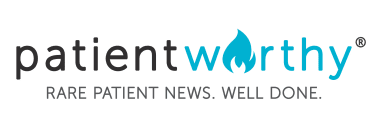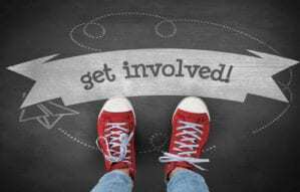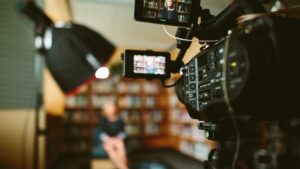
Rare Community Profiles is a Patient Worthy article series of long-form interviews featuring various stakeholders in the rare disease community, such as patients, their families, advocates, scientists, and more.’
The Only One Diagnosed in the US: Why Gabby is Starting Conversations on NLSD-M
It may sound cliche, but Gabby Zeppieri has a smile that can light up a whole room. Or an entire hallway, as evidenced by our first meeting at Rare Disease Day at NIH.
Gabby had a table where she was connecting with attendees to tell them about Gabby’s Wonderful World, the nonprofit organization she founded with her family to raise awareness of Neutral Lipid Storage Disease with Myopathy (NLSD-M).
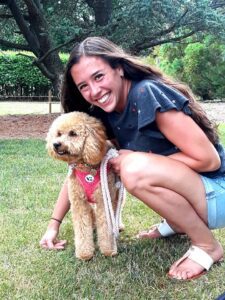
Currently, there are only ~100 known cases of NLSD-M worldwide. Gabby is the only known person with NLSD-M in the United States. Even though raising awareness is a daunting task, Gabby pushes on with a smile and a determination to make a difference, saying:
“For so long, I felt alone on this journey. I felt like nobody knew or understood what I was going through. I started Gabby’s Wonderful World to end isolation in rare disease and help others realize that they’re not alone.”
Of course, it took time to get to this point—Gabby has been cultivating her resilient mindset for years. She’s had ups and she’s had downs, and sometimes, she says:
“I still have my bad days. But I also realize that I don’t know what life is going to look like down the line. My perspective is: let me do the most that I can now and find, and spread, the little joys that come my way.”
Gabby recently sat down with Patient Worthy to share her diagnostic journey, talk more about Gabby’s Wonderful World, and share her goal of creating a more yasashii world.
From Dancing to Diagnosis
The first moment her feet touched the stage, Gabby knew that she was destined to be a dancer. She started dance lessons at age three; the more she took, the more her dream solidified. On stage, she felt creative, open, free. Dance gave her the space to embrace who she was.
For years, Gabby danced—and, outside of that, was known for the energy and positivity she brought to every situation. But it was hard to stay positive when, after a severe stomach virus at age ten, Gabby’s health began declining ever so slightly.
ER physicians first thought Gabby’s appendix had ruptured. Then bloodwork showed signs of elevated liver enzymes and an elevated muscle enzyme called creatine phosphokinase (CPK). Specialist visits abounded. Every doctor seemed to want more tests, and more, and…
Eventually, shares Gabby, she was mis-diagnosed with dermatomyositis, a rare inflammatory autoimmune disorder:
“At the time, I was still a competitive dancer. I danced for hours every week. There were no signs of muscle weakness or pain. The only sign I had was abnormal blood work. I began different treatments and immunosuppressants, but nothing seemed to touch the elevated CPK or liver enzymes. As the years went on, we decided to stop treatment because I was asymptomatic.”
While Gabby’s health seemed to even out, she would get hit with another surprise at age 16. Doctors removing her tonsils realized that the tonsils were infiltrated with lipids—something was not right.
Several more blood tests and a genetic test later, Gabby learned that she had neutral lipid storage disease with myopathy, despite not having any symptoms. At the time, she was the 15th person diagnosed in the world.
Gabby and her mom dove into research—but limited information was available. That didn’t stop them from continuing, though. Says Gabby:
“My mom was constantly researching, searching online, contacting people. She’s the one who first came across the doctor I consult with in Japan, who is one of the few researchers looking into NLSD-M.”
What is NLSD-M?
Neutral lipid storage disease with myopathy is an ultra-rare genetic disease first described in medical literature in 1953. PNPLA2 gene mutations cause NLSD-M. According to Gabby:
“This causes fats, or lipids, to be stored in my tissues and organs. This causes irreversible symptoms and damage.”
Then, leaning on her positive perspective, she adds:
“The mutation I have can either affect your skeletal system or your cardiac system. I feel very fortunate that my heart is not affected.”
Because NLSD-M is still poorly understood, there are still many “unknowns” about this condition. But here’s what we can tell you:
- NLSD-M is diagnosed in approximately 1 in every 1,000,000 people.
- The main symptom of NLSD-M seems to be progressive muscle weakness (myopathy). According to the Genetics and Rare Disease Information Center (GARD), additional symptoms can include:
- Absent reflexes
- Fatigue
- Small involuntary muscle contractions
- Cardiomyopathy
- Difficulty walking or running
- Fatty replacement of skeletal muscles
- Muscle pain
- Hearing impairment
- Neutrophils in people with NLSD-M show signs of multiple cytoplasmic vacuoles of lipid (fat) called Jordans’ anomaly.
The issue with the lack of awareness is that people with NLSD-M cannot necessarily depend on physicians for help or guidance. Says Gabby:
“Sometimes doctors look at me like I’m crazy because they don’t understand what I’m talking about. Many times, I’m brushed off and doctors say, ‘Sorry, we don’t know about NLSD-M. Good luck with another doctor.’ It’s very frustrating and upsetting. Sometimes I walk into an office and feel like an alien. One time, a doctor called my mom ‘desperate’ for pushing for answers. She said, ‘I’m not desperate. I’m fighting for my daughter’s life.’ It can be discouraging. I’m a human being, and I deserve help and care just like someone diagnosed with a common disorder.”
The Onset of Symptoms
Gabby went to school for dance. Still asymptomatic, she wanted to embrace her time doing what she loved. As a ballet pointe dancer, she leaned into the precision; she was driven by the graceful movements, the focus.
But life had other plans.
During her sophomore year of undergrad, Gabby had an injury that sidelined her dance career. She explains:
“I’m a strong believer that everything happens for a reason. I saw my injury as a sign to take a step back and realize that wasn’t the path I was meant to be on. I miss dancing, of course. I love dance. Dance made me who I am today. But physically, it’s not something I could incorporate into my life anymore.”
The muscle weakness began with a whisper—so quiet and minimal that Gabby herself didn’t notice at first. It was her mom who saw first, pointing out one day at dinner that Gabby (who is right hand dominant) was picking up her water with her left hand. Stumped, Gabby grabbed the glass with her right hand. But it didn’t lift.
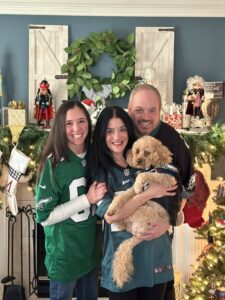
Then, suddenly, symptoms set in. Despite frequent PT/OT visits, the muscle weakness progressed from her right arm, bicep, and shoulder to her left. Now, she shares, her leg muscles are also involved:
“My symptoms affect me tremendously. I get up at 4:40am to go to work, do my job, go to PT/OT and strength training, and am exhausted by the time I get home. I’ve seen other doctors, like a holistic wellness doctor, who told me that my body exists in the same state as someone doing a hard training session. Me walking upstairs is like running 10 miles at your hardest pace. Even showering requires so much energy. I have to think about every move I make. I’ve become the master of compensation, as my OT says. My mindset is that I don’t know what will happen five years down the road, but I want to maintain my independence. If I can still do something on my own, I’m going to do it.”
And she has—Gabby returned to school to get her Master’s degree and now works as a school psychologist. This has driven home for her the importance of mental health support:
“People with rare diseases live their experience every day. We can’t escape; we have to cope. And sometimes that’s hard. For me, what works best is finding joy in what you like to do. Disconnect from what you’re going through—and believe me, I know this is easier said than done. I struggle walking, so disconnecting from that is hard. But I love summer. So I make time to walk over and sit by the pool in my backyard. That brings me joy. I still question, ‘Why me? Why was I chosen for this?’ But as a psychologist, I recognize that I have to apply coping strategies for myself too.”
Launching Gabby’s Wonderful World
The idea for Gabby’s Wonderful World emerged during a local symposium in October 2023. Gabby, along with the researcher working to advance NSLD-M understanding, opened the conference. Patients spoke in Italian, Japanese, and other languages, uniting people across borders.

Finally, the researcher mentioned that a pharmaceutical company was interested in NLSD-M. Gabby and other attendees asked what they could do to persuade that company to create a drug. This was especially important to Gabby, who shares:
“I have been told that enzyme replacement therapy and gene editing would work for me. My doctor in New York reached out to a large pharmaceutical company with my story. That company essentially said, ‘We know what we could do for Gabby, but it isn’t cost-effective.’ That was a knife to the heart. So when I heard the opportunity to discuss research and drug development at this meeting, I jumped at the chance.”
So how could they persuade the companies, said the researcher? They needed pharmaceutical buy-in, researchers and scientists, and money. The best way to get that? Start a nonprofit. Gabby says:
“My family had never done anything like this before. But we saw that the National Organization for Rare Disorders (NORD) offered a virtual session on starting your own nonprofit, so we jumped right on it.”
In her nonprofit, Gabby wanted to center the mission of “creating a Yasashii world.” Yasashii is a Japanese word that translates into gentle, kind, or caring. Says Gabby:
“It’s one of the best lines I’ve ever heard. People can be so harsh sometimes. But let’s be gentle to each other, be kind to each other, and remember that we’re all humans. We’re all struggling so let’s be nice to each other.”
This also led to her Foundation’s mission: “Day by Day, Little by Little.” Gabby explains that her goal is to change the world, to bring awareness, end isolation, and find treatment for NLSD-M. But that requires honoring the small movements forward and everybody who pitches in for change.
Remaining Resilient
At the end of the day, Gabby wants to spark conversation and bring people together. She believes that change comes from opening discourse, not from hiding behind the scenes, explaining:
“I truly believe that there are more of us out there who are misdiagnosed, and doctors don’t know about the disease. If they don’t know about it, they can’t diagnose people with it. Through my Foundation, I want to educate people on NLSD-M. I also want to end feelings of loneliness. I want people to feel like they’re part of something. It can be challenging when we’re spread across the world but having that support and feeling that sense of community is incredibly empowering. Another tenet of my mission is advancing drug development and NLSD-M focused research into gene editing, enzyme replacement therapy, and drug repurposing. We have such a solid group of people who are fighting this fight, and our end goal is to go to pharma and say, “There needs to be more of a balance between profit and providing for those in need even if that number of individuals is small.”
This journey isn’t always easy. Some days, approaching these huge changes feels overwhelming and frustrating. But, says Gabby:
“Life would be boring if you never faced frustration or fear. My mom told me, ‘If you’re dealt something in life, you were meant to handle it. So push forward and give it all you got.’ I can crumple into a ball and sink into a corner, or I can get up every day and live. And I choose to live.”
If you are someone with NLSD-M, who believes they might have NLSD-M, or are a physician or researcher who would like to learn more about NLSD-M, Gabby is open to connecting with you or hearing your feedback. You may contact her at [email protected] or on her website.
